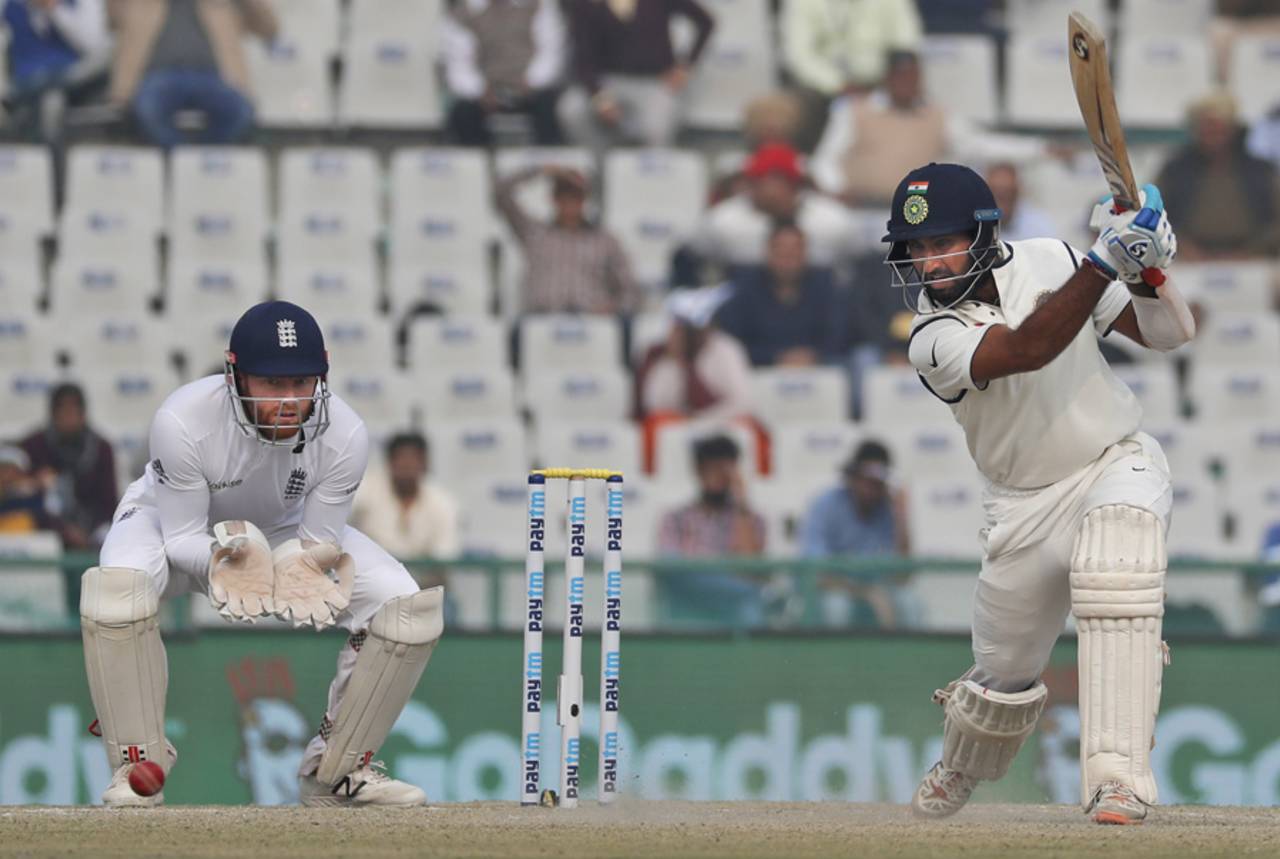Fleet-footed India leave England stumped
Stepping down to spinners is an important skill but, while India have picked the length early and avoided premeditation, England's batsmen have been far less adept
Sidharth Monga in Mumbai
06-Dec-2016

Cheteshwar Pujara has scored close to 15% of his runs against spin in this series by stepping down the track • Associated Press
In the 49th over of the Visakhapatnam Test, Cheteshwar Pujara pulled and drove successive Zafar Ansari deliveries for six and four. To the first ball, he rocked back to manufacture the length a little, and advanced down the crease to take the second on the full. Freeze frames from both these deliveries might illustrate a big difference between the two sides so far.
As Ansari completes his action and the ball leaves his hand, Pujara has pushed on to the front foot to both deliveries. With the first, he sees the ball flat and goes back to use the depth of his crease. With the second, he sees the flight and charges out, not letting it pitch. And there is no way to tell from these freeze frames what Pujara is going to do.
This is Pujara - or any other accomplished Asian batsman - at his best. Ready to move forward, picking the length early, and then attacking any error from the bowler - be it from the back foot or the front foot. Pujara's use of this movement out of the crease is a return to how he played on debut in Bangalore six years ago, charging out at every opportunity after a shooter had done him in in the first innings. In this series, he has charged out once every 8.5 balls of spin he has faced, scoring close to 15% of his runs against spin by stepping down the wicket.
More important, though, is the timing of Pujara's charge. As those two deliveries suggest, he is always on the lookout to go forward, but he is never committed too early or so much that he leaves himself no way to bail out. By contrast, in Mohali, Ben Stokes, Moeen Ali and Jos Buttler gave themselves no second chance and paid with their wickets.
Bowling to Stokes, when Ravindra Jadeja is in an identical position to that of Ansari earlier, you know Stokes is coming. You can tell. It's not just the front foot shuffling across a little but also the movement in his upper body. He comes out all right, and is beaten on the outside edge. The difference between the two charges is a fraction of a second, but that premeditation can be lethal against good spinners. Buttler, looking to bat positively, left his crease often, but twice he charged out without reaching the pitch of the ball. The result: he was caught at short cover once, and dragged the other intended straight hit into the waiting hands of cow corner.
For the second time in the series, Moeen left the crease, found himself nowhere close to the pitch of the ball, froze and paid the ultimate price - lbw once, and chipping one to mid-on on another occasion. Moeen is often guilty of leaving the crease with premeditation and then not knowing what to do. His dismissal giving Yasir Shah the charge at Lord's is a better known case in point.
Now, it is up for debate whether spinners see that movement a fraction of a second too soon even as they are in the process of delivering. The bluff masters that they are, the spinners will tell you they do, but it is fair to assume they don't always spot it. Even if they don't always do, as batsmen you don't want to leave yourselves exposed to those occasions when they adjust and bowl wider or shorter.
It doesn't help England that their spinners - apart from Adil Rashid - haven't done much with the ball in the air. The Ashwin ball that got Moeen in Mohali dipped on him and drifted appreciably into the pads. Jadeja got Stokes with one that drifted away from his bat. Add Joe Root's dismissal in Visakhapatnam, and England have lost six wickets with batsmen out of the crease; India haven't lost even one to a proper charge.
It's not as though India batsmen haven't ventured out: Pujara and M Vijay in particular have frequently used their feet to reach balls before they turn, but they have been more effective. Their charges have been less premeditated and swift once they do come at the ball. While Pujara has not hit one ball in the air after advancing down the wicket, Vijay has left the crease with the sole intention of hitting over the straight field to get himself a release from the intense concentration his game needs. Even when the batsmen have charged out too soon, there hasn't been much aerial deception from England's spinners.
To leave the crease and take a spinner on is an important tool for a batsman, but England have been doing so a fraction of a second too soon, and against better spinners.
Sidharth Monga is an assistant editor at ESPNcricinfo